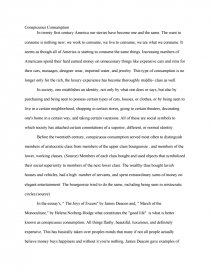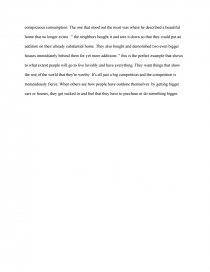Conspicusous Consumption
Essay by review • January 22, 2011 • Essay • 465 Words (2 Pages) • 1,043 Views
Conspicuous Consumption
In twenty first century America our stories have become one and the same. The want to consume is nothing new; we work to consume, we live to consume, we are what we consume. It seems as though all of America is starting to consume the same things. Increasing numbers of Americans spend their hard earned money on unnecessary things like expensive cars and rims for their cars; massages, designer wear, imported water, and jewelry. This type of consumption is no longer only for the rich, the luxury experience has become thoroughly middle- class as well.
In society, one establishes an identity, not only by what one does or says, but also by purchasing and being seen to possess certain types of cars, houses, or clothes, or by being seen to live in a certain neighborhood, shopping in certain stores, going to certain theaters, decorating one's home in a certain way, and taking certain vacations. All of these are social symbols to which society has attached certain connotations of a superior, different, or normal identity.
Before the twentieth century, conspicuous consumption served most often to distinguish members of aristocratic class from members of the upper class bourgeoisie , and members of the lower, working classes. (Source) Members of each class bought and used objects that symbolized their social superiority to members of the next lower class. The wealthy thus bought lavish houses and vehicles, had a high number of servants, and spent extraordinary sums of money on elegant entertainment. The bourgeoisie tried to do the same, including being seen in aristocratic circles.(source)
In the esssay's, " The Joys of Excess" by James Deacon and, " March of the Monoculture," by Helena Norberg-Hodge what constitutes the "good life" is what is better known as conspicuous consumption; All things flashy, beautiful, luxurious, and definitely expensive. This has basically taken over peoples minds that many if not all people actually believe money buys happiness and without it you're nothing. James Deacon gave examples of conspicuous consumption. The one that stood out the most was where he described a beautiful home that no longer exists. " the neighbors bought it and tore it down so that they could put an addition on their already substantial home. They also bought and demolished two even bigger houses immediately behind them
...
...

